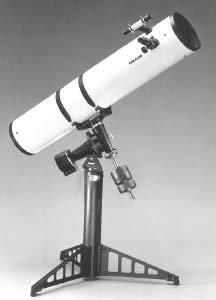 In a word - value. A Newtonian reflector offers more performance for your observing dollar than any other telescope type.
In a word - value. A Newtonian reflector offers more performance for your observing dollar than any other telescope type.
The reflector's large light-gathering area and relatively short focal length can provide bright images of deep space objects that are too faint for any small aperture refractor to see. And the reflector's large aperture can resolve details within those objects with a precision no small scope can match - if the seeing is good.
The penalty you pay for this performance is typically one of large size and weight - although not necessarily one of high cost, as reflectors traditionally cost the fewest dollars per inch of aperture of any telescope type.
The reason? A reflector has only one mirror to grind and polish to a precise curve (with an accuracy of +/-five one-millionths of an inch or better). A refractor, on the other hand, has two to four lenses, with a total of four to eight precisely curved surfaces to shape. And those lenses might have to be costly exotic glass formulations in order to provide satisfactory images. Similarly, a catadioptric scope has three or four curved optical elements to shape to a high degree of accuracy.
All that extra mirror and lens grinding and costly optical glass types in refractors and catadioptrics doesn't come cheap. That makes the one-curved-mirror/one-flat-mirror optics of a reflector the least expensive to make, and hence the lowest in cost per inch of aperture.
For the same amount of money, therefore, you get more aperture with a reflector than with any other scope type. And with all other things being equal, the bigger the aperture, the better the performance. An 8" reflector typically costs 50% less than a quality 4" refractor, and little more than 3.5" catadioptric, but will have four times the light grasp of either.
For purely visual deep space observing, Dobsonian reflectors are very cost-effective. With huge mirrors (up to 24" and more in diameter) to gather light, and inexpensive wood mounts, these new Newtonians have brought about the age of the "light bucket" in amateur astronomy. The deep space observer on a budget has never had it so good.
The astrophotographer will also find that a large aperture equatorial mount reflector is excellent for recording deep space objects in detail, as well as visual observing. (Photography is not possible with an altazimuth Dobsonian reflector.)
The drawbacks of a reflector? There are five - diffraction, coma, size, weight, and added maintenance.
Light diffracted, or scattered, by a reflector's diagonal mirror can reduce image contrast in lunar and planetary observing, masking subtle surface details compared with an unobstructed refractor image. In addition, diffraction spikes on star images, due to the spider vanes that hold the diagonal mirror, can mask faint binary star components and smear globular cluster detail.
Because of the parabolic shape of their primary mirrors, all reflectors have coma - an optical defect in which stars appear triangular or comet-shaped at the edge of the field. The faster the focal ratio, the smaller the coma-free field. This can be annoying in photos, where the entire field is available for leisurely inspection. It is usually unobjectionable visually, however, since objects of interest are normally kept in the center of the field, where eyes and eyepieces are sharpest and coma is less of a factor.
Since an equatorially-mounted 8" reflector can weigh 50% more than a fork-mounted 8" catadioptric, and the reflector's 48" long optical tube is not the easiest thing in the world to manage in an apartment elevator, a large reflector usually requires the elbow room afforded by a suburban environment.
Also, since city light pollution almost invariably compromises deep space performance by washing out faint nebulas and galaxies, dark sky observing sites are always recommended with medium to large aperture reflectors. Large aperture reflectors (12"-16" and larger) almost invariably require a minivan or SUV for transport to the dark sky sites they need to avoid being overwhelmed by the effects of city and suburban light pollution. They often also need some friends to help you with the setup of the bulky components. Owning and using a large reflector can be more of a lifestyle than a hobby.
In addition, unlike refractors or catadioptric telescopes, a reflector requires frequent re-collimation or alignment of its optics, and its exposed mirrors mean that periodic cleaning will also be required. However, this maintenance typically averages only a few additional minutes of work per observing session.
These drawbacks aside, for serious visual observing of faint galaxies and nebulas, as well as for more-than-acceptable lunar and planetary observing, you'd be hard-pressed to equal, much less surpass, the excellent price-to-performance ratio of a Newtonian reflector. Reflectors have been a best-seller for over 300 years - and sheer value for the money is why.
REFLECTOR REPORT CARDS FOR VISUAL USE
(used in excellent seeing conditions and with no light pollution; adapted from Astronomy Magazine):
E = excellent; VG = very good; G = good; F = fair; P = poor.
Small aperture (3" to 6") reflectors:
Price range: $120-$1000
Portability: E
Ease of setup: VG
Ease of use: VG+
Performance on the Moon: E
Performance on comets: F
Performance on double stars: VG
Performance on galaxies and nebulas: F
Performance on planets: VG
Medium aperture (8" to 12.5") reflectors:
Price range: $400-$14,000
Portability: F
Ease of setup: F
Ease of use: VG+
Performance on the Moon: E
Performance on comets: VG
Performance on double stars: VG
Performance on galaxies and nebulas: VG
Performance on planets: VG
Large aperture (13" and larger) reflectors:
Price range: $1200-$36,000
Portability: F
Ease of setup: P+
Ease of use: G+
Performance on the Moon: VG
Performance on comets: E
Performance on double stars: E
Performance on galaxies and nebulas: E
Performance on planets: E








